Ultrarelativistic positronium production in collisions of high energy electrons and laser p
- 格式:pdf
- 大小:79.90 KB
- 文档页数:12
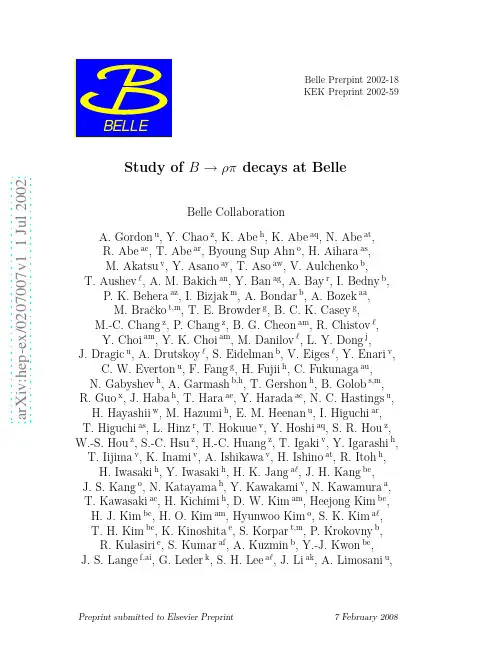
a r X i v :h e p -e x /0207007v 1 1 J u l 2002BELLEBelle Prerpint 2002-18KEK Preprint 2002-59Study of B →ρπdecays at BelleBelle Collaboration A.Gordon u ,Y.Chao z ,K.Abe h ,K.Abe aq ,N.Abe at ,R.Abe ac ,T.Abe ar ,Byoung Sup Ahn o ,H.Aihara as ,M.Akatsu v ,Y.Asano ay ,T.Aso aw ,V.Aulchenko b ,T.Aushev ℓ,A.M.Bakich an ,Y.Ban ag ,A.Bay r ,I.Bedny b ,P.K.Behera az ,jak m ,A.Bondar b ,A.Bozek aa ,M.Braˇc ko t ,m ,T.E.Browder g ,B.C.K.Casey g ,M.-C.Chang z ,P.Chang z ,B.G.Cheon am ,R.Chistov ℓ,Y.Choi am ,Y.K.Choi am ,M.Danilov ℓ,L.Y.Dong j ,J.Dragic u ,A.Drutskoy ℓ,S.Eidelman b ,V.Eiges ℓ,Y.Enari v ,C.W.Everton u ,F.Fang g ,H.Fujii h ,C.Fukunaga au ,N.Gabyshev h ,A.Garmash b ,h ,T.Gershon h ,B.Golob s ,m ,R.Guo x ,J.Haba h ,T.Hara ae ,Y.Harada ac ,N.C.Hastings u ,H.Hayashii w ,M.Hazumi h ,E.M.Heenan u ,I.Higuchi ar ,T.Higuchi as ,L.Hinz r ,T.Hokuue v ,Y.Hoshi aq ,S.R.Hou z ,W.-S.Hou z ,S.-C.Hsu z ,H.-C.Huang z ,T.Igaki v ,Y.Igarashi h ,T.Iijima v ,K.Inami v ,A.Ishikawa v ,H.Ishino at ,R.Itoh h ,H.Iwasaki h ,Y.Iwasaki h ,H.K.Jang a ℓ,J.H.Kang bc ,J.S.Kang o ,N.Katayama h ,Y.Kawakami v ,N.Kawamura a ,T.Kawasaki ac ,H.Kichimi h ,D.W.Kim am ,Heejong Kim bc ,H.J.Kim bc ,H.O.Kim am ,Hyunwoo Kim o ,S.K.Kim a ℓ,T.H.Kim bc ,K.Kinoshita e ,S.Korpar t ,m ,P.Krokovny b ,R.Kulasiri e ,S.Kumar af ,A.Kuzmin b ,Y.-J.Kwon bc ,nge f ,ai ,G.Leder k ,S.H.Lee a ℓ,J.Li ak ,A.Limosani u ,D.Liventsevℓ,R.-S.Lu z,J.MacNaughton k,G.Majumder ao, F.Mandl k,D.Marlow ah,S.Matsumoto d,T.Matsumoto au,W.Mitaroffk,K.Miyabayashi w,Y.Miyabayashi v,H.Miyake ae,H.Miyata ac,G.R.Moloney u,T.Mori d,T.Nagamine ar,Y.Nagasaka i,T.Nakadaira as,E.Nakano ad, M.Nakao h,J.W.Nam am,Z.Natkaniec aa,K.Neichi aq, S.Nishida p,O.Nitoh av,S.Noguchi w,T.Nozaki h,S.Ogawa ap, T.Ohshima v,T.Okabe v,S.Okuno n,S.L.Olsen g,Y.Onuki ac, W.Ostrowicz aa,H.Ozaki h,P.Pakhlovℓ,H.Palka aa,C.W.Park o,H.Park q,L.S.Peak an,J.-P.Perroud r, M.Peters g,L.E.Piilonen ba,J.L.Rodriguez g,F.J.Ronga r, N.Root b,M.Rozanska aa,K.Rybicki aa,H.Sagawa h,S.Saitoh h,Y.Sakai h,M.Satapathy az,A.Satpathy h,e,O.Schneider r,S.Schrenk e,C.Schwanda h,k,S.Semenovℓ,K.Senyo v,R.Seuster g,M.E.Sevior u,H.Shibuya ap,V.Sidorov b,J.B.Singh af,S.Staniˇc ay,1,M.Stariˇc m,A.Sugi v, A.Sugiyama v,K.Sumisawa h,T.Sumiyoshi au,K.Suzuki h,S.Suzuki bb,S.Y.Suzuki h,T.Takahashi ad,F.Takasaki h, K.Tamai h,N.Tamura ac,J.Tanaka as,M.Tanaka h,G.N.Taylor u,Y.Teramoto ad,S.Tokuda v,S.N.Tovey u,T.Tsuboyama h,T.Tsukamoto h,S.Uehara h,K.Ueno z, Y.Unno c,S.Uno h,hiroda h,G.Varner g,K.E.Varvell an,C.C.Wang z,C.H.Wang y,J.G.Wang ba,M.-Z.Wang z,Y.Watanabe at,E.Won o,B.D.Yabsley ba,Y.Yamada h, A.Yamaguchi ar,Y.Yamashita ab,M.Yamauchi h,H.Yanai ac,P.Yeh z,Y.Yuan j,Y.Yusa ar,J.Zhang ay,Z.P.Zhang ak,Y.Zheng g,and D.ˇZontar aya Aomori University,Aomori,Japanb Budker Institute of Nuclear Physics,Novosibirsk,Russiac Chiba University,Chiba,Japand Chuo University,Tokyo,Japane University of Cincinnati,Cincinnati,OH,USAf University of Frankfurt,Frankfurt,Germanyg University of Hawaii,Honolulu,HI,USAh High Energy Accelerator Research Organization(KEK),Tsukuba,Japani Hiroshima Institute of Technology,Hiroshima,Japanj Institute of High Energy Physics,Chinese Academy of Sciences,Beijing,PRChinak Institute of High Energy Physics,Vienna,Austria ℓInstitute for Theoretical and Experimental Physics,Moscow,Russiam J.Stefan Institute,Ljubljana,Slovenian Kanagawa University,Yokohama,Japano Korea University,Seoul,South Koreap Kyoto University,Kyoto,Japanq Kyungpook National University,Taegu,South Korear Institut de Physique des Hautes´Energies,Universit´e de Lausanne,Lausanne,Switzerlands University of Ljubljana,Ljubljana,Sloveniat University of Maribor,Maribor,Sloveniau University of Melbourne,Victoria,Australiav Nagoya University,Nagoya,Japanw Nara Women’s University,Nara,Japanx National Kaohsiung Normal University,Kaohsiung,Taiwany National Lien-Ho Institute of Technology,Miao Li,Taiwanz National Taiwan University,Taipei,Taiwanaa H.Niewodniczanski Institute of Nuclear Physics,Krakow,Polandab Nihon Dental College,Niigata,Japanac Niigata University,Niigata,Japanad Osaka City University,Osaka,Japanae Osaka University,Osaka,Japanaf Panjab University,Chandigarh,Indiaag Peking University,Beijing,PR Chinaah Princeton University,Princeton,NJ,USAai RIKEN BNL Research Center,Brookhaven,NY,USAaj Saga University,Saga,Japanak University of Science and Technology of China,Hefei,PR ChinaaℓSeoul National University,Seoul,South Koreaam Sungkyunkwan University,Suwon,South Koreaan University of Sydney,Sydney,NSW,Australiaao Tata Institute of Fundamental Research,Bombay,Indiaap Toho University,Funabashi,Japanaq Tohoku Gakuin University,Tagajo,Japanar Tohoku University,Sendai,Japanas University of Tokyo,Tokyo,Japanat Tokyo Institute of Technology,Tokyo,Japanau Tokyo Metropolitan University,Tokyo,Japanav Tokyo University of Agriculture and Technology,Tokyo,Japanaw Toyama National College of Maritime Technology,Toyama,Japanay University of Tsukuba,Tsukuba,Japanaz Utkal University,Bhubaneswer,Indiaba Virginia Polytechnic Institute and State University,Blacksburg,VA,USAbb Yokkaichi University,Yokkaichi,Japanbc Yonsei University,Seoul,South KoreaB events collected with the Belle detector at KEKB.Thebranching fractions B(B+→ρ0π+)=(8.0+2.3+0.7−2.0−0.7)×10−6and B(B0→ρ±π∓)=(20.8+6.0+2.8−6.3−3.1)×10−6are obtained.In addition,a90%confidence level upper limitof B(B0→ρ0π0)<5.3×10−6is reported.Key words:ρπ,branching fractionPACS:13.25.hw,14.40.Nd1on leave from Nova Gorica Polytechnic,Nova Gorica,Sloveniamodes are examined.Here and throughout the text,inclusion of charge con-jugate modes is implied and for the neutral decay,B0→ρ±π∓,the notation implies a sum over both the modes.The data sample used in this analysis was taken by the Belle detector[9]at KEKB[10],an asymmetric storage ring that collides8GeV electrons against3.5GeV positrons.This produces Υ(4S)mesons that decay into B0B pairs.The Belle detector is a general purpose spectrometer based on a1.5T su-perconducting solenoid magnet.Charged particle tracking is achieved with a three-layer double-sided silicon vertex detector(SVD)surrounded by a central drift chamber(CDC)that consists of50layers segmented into6axial and5 stereo super-layers.The CDC covers the polar angle range between17◦and 150◦in the laboratory frame,which corresponds to92%of the full centre of mass(CM)frame solid angle.Together with the SVD,a transverse momen-tum resolution of(σp t/p t)2=(0.0019p t)2+(0.0030)2is achieved,where p t is in GeV/c.Charged hadron identification is provided by a combination of three devices: a system of1188aerogelˇCerenkov counters(ACC)covering the momentum range1–3.5GeV/c,a time-of-flight scintillation counter system(TOF)for track momenta below1.5GeV/c,and dE/dx information from the CDC for particles with very low or high rmation from these three devices is combined to give the likelihood of a particle being a kaon,L K,or pion, Lπ.Kaon-pion separation is then accomplished based on the likelihood ratio Lπ/(Lπ+L K).Particles with a likelihood ratio greater than0.6are identified as pions.The pion identification efficiencies are measured using a high momentum D∗+data sample,where D∗+→D0π+and D0→K−π+.With this pion selection criterion,the typical efficiency for identifying pions in the momentum region0.5GeV/c<p<4GeV/c is(88.5±0.1)%.By comparing the D∗+data sample with a Monte Carlo(MC)sample,the systematic error in the particle identification(PID)is estimated to be1.4%for the mode with three charged tracks and0.9%for the modes with two.Surrounding the charged PID devices is an electromagnetic calorimeter(ECL) consisting of8736CsI(Tl)crystals with a typical cross-section of5.5×5.5cm2 at the front surface and16.2X0in depth.The ECL provides a photon energy resolution of(σE/E)2=0.0132+(0.0007/E)2+(0.008/E1/4)2,where E is in GeV.Electron identification is achieved by using a combination of dE/dx measure-ments in the CDC,the response of the ACC and the position and shape of the electromagnetic shower from the ECL.Further information is obtained from the ratio of the total energy registered in the calorimeter to the particle momentum,E/p lab.Charged tracks are required to come from the interaction point and have transverse momenta above100MeV/c.Tracks consistent with being an elec-tron are rejected and the remaining tracks must satisfy the pion identification requirement.The performance of the charged track reconstruction is studied using high momentumη→γγandη→π+π−π0decays.Based on the relative yields between data and MC,we assign a systematic error of2%to the single track reconstruction efficiency.Neutral pion candidates are detected with the ECL via their decayπ0→γγ. Theπ0mass resolution,which is asymmetric and varies slowly with theπ0 energy,averages toσ=4.9MeV/c2.The neutral pion candidates are selected fromγγpairs by requiring that their invariant mass to be within3σof the nominalπ0mass.To reduce combinatorial background,a selection criteria is applied to the pho-ton energies and theπ0momenta.Photons in the barrel region are required to have energies over50MeV,while a100MeV requirement is made for photons in the end-cap region.Theπ0candidates are required to have a momentum greater than200MeV/c in the laboratory frame.Forπ0s from BE2beam−p2B and the energy difference∆E=E B−E beam.Here, p B and E B are the momentum and energy of a B candidate in the CM frame and E beam is the CM beam energy.An incorrect mass hypothesis for a pion or kaon produces a shift of about46MeV in∆E,providing extra discrimination between these particles.The width of the M bc distributions is primarily due to the beam energy spread and is well modelled with a Gaussian of width 3.3MeV/c2for the modes with a neutral pion and2.7MeV/c2for the mode without.The∆E distribution is found to be asymmetric with a small tail on the lower side for the modes with aπ0.This is due toγinteractions withmaterial in front of the calorimeter and shower leakage out of the calorimeter. The∆E distribution can be well modelled with a Gaussian when no neutral particles are present.Events with5.2GeV/c2<M bc<5.3GeV/c2and|∆E|< 0.3GeV are selected for thefinal analysis.The dominant background comes from continuum e+e−→qB events and jet-like qi,j|p i||p j|P l(cosθij)i,k|p i||p k|,r l=),where L s and L qqD0π+ decays.By comparing the yields in data and MC after the likelihood ratiorequirement,the systematic errors are determined to be4%for the modes with aπ0and6%for the mode without.Thefinal variable used for continuum suppression is theρhelicity angle,θh, defined as the angle between the direction of the decay pion from theρin the ρrest frame and theρin the B rest frame.The requirement of|cosθh|>0.3 is made independently of the likelihood ratio as it is effective in suppressing the background from B decays as well as the qB events is used[14].The largest component of this background is found to come from decays of the type B→Dπ;when the D meson decays via D→π+π−,events can directly reach the signal region while the decay D→K−π+can reach the signal region with the kaon misidentified as a pion.Decays with J/ψandψ(2S) mesons can also populate the signal region if both the daughter leptons are misidentified as pions.These events are excluded by making requirements on the invariant mass of the intermediate particles:|M(π+π−)−M D0|>0.14 GeV/c2,|M(π+π0)−M D+|>0.05GeV/c2,|M(π+π−)−M J/ψ|>0.07GeV/c2 and|M(π+π−)−Mψ(2S)|>0.05GeV/c2.The widest cut is made around the D0mass to account for the mass shift due to misidentifying the kaons in D0 decays as pions.Fig.1shows the∆E and M bc distributions for the three modes analysed after all the selection criteria have been applied.The∆E and M bc plots are shown for events that lie within3σof the nominal M bc and∆E values,respectively. The signal yields are obtained by performing maximum likelihoodfits,each using a single signal function and one or more background functions.The signal functions are obtained from the MC and adjusted based on comparisons of B+→B0are assumed to be equal.The M bc distribution for all modes isfitted with a single Gaussian and an ARGUS background function[15].The normalization of the ARGUS function is left tofloat and shape of the function isfixed from the∆E sideband:−0.25 GeV<∆E<−0.08GeV and5.2GeV/c2<M bc<5.3GeV/c2.For the mode with only charged pions in thefinal state,the∆E distribution isfitted with a single Gaussian for the signal and a linear function withfixed shape for the continuum background.The normalization of the linear function is left to float and the slope isfixed from the M bc sideband,5.2GeV/c2<M bc<5.26GeV/c2,|∆E|<0.3GeV.There are also other rare B decays that are expected to contaminate the∆E distribution.For the mode without aπ0,these modes are of the type B0→h+h−(where h denotes aπor K),B→ρρ(including all combinations of charged and neutralρmesons,where the polarizations of theρmesons are assumed to be longitudinal)and B→Kππ(including the decays B+→ρ0K+,B+→K∗0π+,B+→K∗0(1430)0π+,B+→f0(980)K+ and B+→f0(1370)K+)[16].These background modes are accounted for by using smoothed histograms whose shapes have been determined by combining MC distributions.The three B→ρρmodes are combined into one histogram. The normalization of this component is allowed tofloat in thefit due to the uncertainty in the branching fractions of the B→ρρmodes.Likewise,the B→hh and all the B→Kππmodes are combined to form one hh and one Kππcomponent.The normalizations of these components arefixed to their expected yields,which are calculated using efficiencies determined by MC and branching fractions measured by previous Belle analyses[16,17].The∆Efits for the modes with aπ0in thefinal state have the signal compo-nent modelled by a Crystal Ball function[18]to account for the asymmetry in the∆E distribution.As for the B+→ρ0π+mode,the continuum background is modelled by a linear function withfixed slope.Unlike the B+→ρ0π+mode, a component is included for the background from the b→c transition.The pa-rameterization for rare B decays includes one component for the B→Kππ0 modes(B0→ρ+K−and B0→K∗+π−)[19]and one for all the B→ρρmodes.The normalization of the B→ρρcomponent is left tofloat while the other components from B decays arefixed to their expected yields.Table1summarizes the results of the∆Efits,showing the number of events, signal yields,reconstruction efficiencies,statistical significance and branching fractions or upper limits for eachfit.The statistical significance is defined assystematic error in thefitted signal yield is estimated by independently varying eachfixed parameter in thefit by1σ.Thefinal results are B(B+→ρ0π+)=(8.0+2.3+0.7−2.0−0.7)×10−6and B(B0→ρ±π∓)=(20.8+6.0+2.8−6.3−3.1)×10−6where thefirst error is statistical and the second is systematic.For theρ0π0mode,one standard deviation of the systematic error is added to the statistical limit to obtain a conservative upper limit at90%confidence of5.3×10−6.The possibility of a nonresonant B→πππbackground is also examined.To check for this type of background,the M bc and∆E yields are determined for differentππinvariant mass bins.Byfitting the M bc distribution inππinvariant mass bins with B→ρπand B→πππMC distributions,the nonresonant contribution is found to be below4%.To account for this possible background, errors3.7%and3.2%are added in quadrature to the systematic errors of the ρ+π−andρ0π+modes,respectively.Theππinvariant mass distributions are shown in Fig.2.Two plots are shown for theρ+π−andρ0π+modes,one with events from the M bc sideband superimposed over the events from the signal region(upper)and one with events from signal MC superimposed over events from the signal region with the sideband subtracted(lower).Fig.3 shows the distribution of the helicity variable,cosθh,for the two modes with all selection criteria applied except the helicity condition.Events fromρπdecays are expected to follow a cos2θdistribution while nonresonant and other background decays have an approximately uniform distribution.The helicity plots are obtained byfitting the M bc distribution in eight helicity bins ranging from−1to1.The M bc yield is then plotted against the helicity bin for each mode and the expected MC signal distributions are superimposed.Both the ππmass spectrum and the helicity distributions provide evidence that the signal events are consistent with being fromρπdecays.The results obtained here can be used to calculate the ratio of branching frac-tions R=B(B0→ρ±π∓)/B(B+→ρ0π+),which gives R=2.6±1.0±0.4, where thefirst error is statistical and second is systematic.This is consistent with values obtained by CLEO[20]and BaBar[21,22]as shown in Table2. Theoretical calculations done at tree level assuming the factorization approx-imation for the hadronic matrix elements give R∼6[3].Calculations that include penguin contributions,off-shell B∗excited states or additionalππres-onances[4–8]might yield better agreement with the the measured value of R.In conclusion,statistically significant signals have been observed in the B→ρπmodes using a31.9×106BWe wish to thank the KEKB accelerator group for the excellent operation of the KEKB accelerator.We acknowledge support from the Ministry of Ed-ucation,Culture,Sports,Science,and Technology of Japan and the Japan Society for the Promotion of Science;the Australian Research Council and the Australian Department of Industry,Science and Resources;the National Science Foundation of China under contract No.10175071;the Department of Science and Technology of India;the BK21program of the Ministry of Education of Korea and the CHEP SRC program of the Korea Science and Engineering Foundation;the Polish State Committee for Scientific Research under contract No.2P03B17017;the Ministry of Science and Technology of the Russian Federation;the Ministry of Education,Science and Sport of the Republic of Slovenia;the National Science Council and the Ministry of Education of Taiwan;and the U.S.Department of Energy.References[1] A.E.Snyder and H.R.Quinn,Phys.Rev.D48,2139(1993).[2]I.Bediaga,R.E.Blanco,C.G¨o bel,and R.M´e ndez-Galain,Phys.Rev.Lett.81,4067(1998).[3]M.Bauer,B.Stech,and M.Wirbel,Z.Phys.C34,103(1987).[4] A.Deandrea et al.,Phys.Rev.D62,036001(2000).[5]Y.H.Chen,H.Y.Cheng,B.Tseng and K.C.Yang,Phys.Rev.D60,094014(1999).[6] C.D.Lu and M.Z.Yang,Eur.Phys.J C23,275(2002).[7]J.Tandean and S.Gardner,SLAC-PUB-9199;hep-ph/0204147.[8]S.Gardner and Ulf-G.Meißner,Phys.Rev.D65,094004(2002).[9]Belle Collaboration,A.Abashian et al.,Nucl.Instr.and Meth.A479,117(2002).[10]E.Kikutani ed.,KEK Preprint2001-157(2001),to appear in Nucl.Instr.andMeth.A.[11]G.C.Fox and S.Wolfram,Phys.Rev.Lett.41,1581(1978).[12]This modification of the Fox-Wolfram moments wasfirst proposed in a seriesof lectures on continuum suppression at KEK by Dr.R.Enomoto in May and June of1999.For a more detailed description see Belle Collaboration,K.Abe et al.,Phys.Lett.B511,151(2001).[13]CLEO Collaboration,D.M.Asner et al.,Phys.Rev.D53,1039(1996).[14]These MC events are generated with the CLEO group’s QQ program,see/public/CLEO/soft/QQ.The detector response is simulated using GEANT,R.Brun et al.,GEANT 3.21,CERN Report DD/EE/84-1,1984.[15]The ARGUS Collaboration,H.Albrecht et al.,Phys.Lett.B241,278(1990).[16]Belle Collaboration,A.Garmash et al.,Phys.Rev.D65,092005(2002).[17]Belle Collaboration,K.Abe et al.,Phys.Rev.Lett.87,101801(2001).[18]J.E.Gaiser et al.,Phys.Rev.D34,711(1986).[19]Belle Collaboration,K.Abe et al.,BELLE-CONF-0115,submitted as acontribution paper to the2001International Europhysics Conference on High Energy Physics(EPS-HEP2001).[20]CLEO Collaboration,C.P.Jessop et al.,Phys.Rev.Lett.85,2881(2000).[21]Babar Collaboration,B.Aubert et al.,submitted as a contribution paper tothe20th International Symposium on Lepton and Photon Interactions at High Energy(LP01);hep-ex/0107058.[22]BaBar Collaboration,B.Aubert et al.,submitted as a contribution paper tothe XXXth International Conference on High Energy Physics(ICHEP2000);hep-ex/0008058.Table1∆Efit results.Shown for each mode are the number of events in thefit,the signal yield,the reconstruction efficiency,the branching fraction(B)or90%confidence level upper limit(UL)and the statistical significance of thefit.Thefirst error in the branching fraction is statistical,the second is systematic.ρ0π+15424.3+6.9−6.29.68.0+2.3+0.7−2.0−0.74.4σρ+π−30144.6+12.8−13.46.820.8+6.0+2.8−6.3−3.13.7σρ0π0116−4.4±8.58.5<5.3-Experiment B(B0→ρ±π∓)×10−6B(B+→ρ0π+)×10−6RE v e n t s /16 M e VE v e n t s /3 M e V /c2(b) ρ0π+Signal backgrd02.557.51012.51517.52022.55.25.225 5.25 5.2755.3E v e n t s /18 M e VE v e n t s /2 M e V /c2(d) ρ+π-Signal backgrd051015202530355.25.225 5.25 5.2755.3∆E(GeV)E v e n t s /18 M e V(e) ρ0π024681012-0.2-0.10.10.2(GeV/c 2)E v e n t s /2 M e V /c2M bc (f) ρ0πSignal backgrd02468101214165.25.225 5.25 5.2755.3Fig.1.The ∆E (left)and M bc (right)fits to the three B →ρπmodes:ρ0π+,ρ+π−and ρ0π0.The histograms show the data,the solid lines show the total fit and the dashed lines show the continuum component.In (a)the contribution from the B →ρρand B →hh modes is shown by the cross hatched component.In (c)the cross hatched component shows the contribution from the b →c transition and B →ρρmodes.102030405060+0(GeV/c 2)E v e n t s /0.1 G e V /c2M(π+π0)(GeV/c 2)E v e n t s /0.1 G e V /c2(GeV/c 2)E v e n t s /0.1 G e V /c2+-(GeV/c 2)E v e n t s /0.1 G e V /c2M(π+ π-)510152025Fig.2.The M (ππ)distributions for B 0→ρ±π∓(left)and B +→ρ0π+(right)events in the signal region.Plots (a)and (b)show sideband events superimposed;plots (c)and (d)show the sideband subtracted plots with signal MC superimposed.-1-0.500.51M b c y i e l d (E v e n t s )cos θh-1-0.500.51M b c y i e l d (E v e n t s )cos θhFig.3.The ρmeson helicity distributions for B 0→ρ±π∓(a)and B +→ρ0π+(b).Signal MC distributions are shown superimposed.。


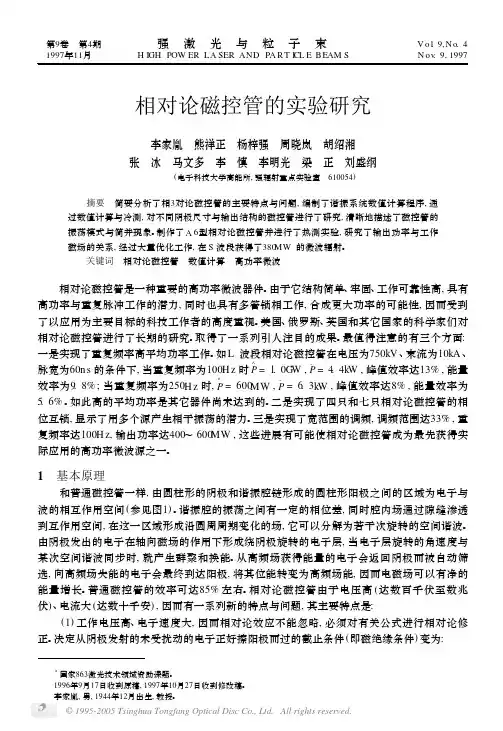
3国家863激光技术领域资助课题。
1996年9月17日收到原稿,1997年10月27日收到修改稿。
李家胤,男,1944年12月出生,教授。
相对论磁控管的实验研究李家胤 熊祥正 杨梓强 周晓岚 胡绍湘张 冰 马文多 李 慎 李明光 梁 正 刘盛纲 (电子科技大学高能所,强辐射重点实验室 610054) 摘要 简要分析了相3对论磁控管的主要特点与问题,编制了谐振系统数值计算程序,通过数值计算与冷测,对不同阴极尺寸与输出结构的磁控管进行了研究,清晰地描述了磁控管的振荡模式与简并现象。
制作了A 6型相对论磁控管并进行了热测实验,研究了输出功率与工作磁场的关系,经过大量优化工作,在S 波段获得了380MW 的微波辐射。
关键词 相对论磁控管 数值计算 高功率微波 相对论磁控管是一种重要的高功率微波器件。
由于它结构简单、牢固、工作可靠性高,具有高功率与重复脉冲工作的潜力,同时也具有多管锁相工作,合成更大功率的可能性,因而受到了以应用为主要目标的科技工作者的高度重视。
美国、俄罗斯、英国和其它国家的科学家们对相对论磁控管进行了长期的研究。
取得了一系列引人注目的成果。
最值得注意的有三个方面:一是实现了重复频率高平均功率工作。
如L 波段相对论磁控管在电压为750kV 、束流为10kA 、脉宽为60n s 的条件下,当重复频率为100H z 时P ^=1.0G W ,P -=4.4k W ,峰值效率达13%,能量效率为9.8%;当重复频率为250H z 时,P ^=600MW ,P -=6.3k W ,峰值效率达8%,能量效率为5.6%。
如此高的平均功率是其它器件尚未达到的。
二是实现了四只和七只相对论磁控管的相位互锁,显示了用多个源产生相干振荡的潜力。
三是实现了宽范围的调频,调频范围达33%,重复频率达100H z ,输出功率达400~600MW ,这些进展有可能使相对论磁控管成为最先获得实际应用的高功率微波源之一。
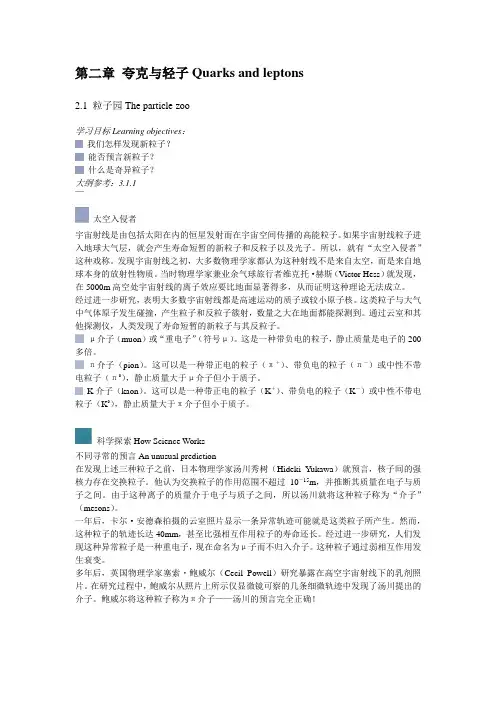
第二章夸克与轻子Quarks and leptons2.1 粒子园The particle zoo学习目标Learning objectives:我们怎样发现新粒子?能否预言新粒子?什么是奇异粒子?大纲参考:3.1.1 ̄太空入侵者宇宙射线是由包括太阳在内的恒星发射而在宇宙空间传播的高能粒子。
如果宇宙射线粒子进入地球大气层,就会产生寿命短暂的新粒子和反粒子以及光子。
所以,就有“太空入侵者”这种戏称。
发现宇宙射线之初,大多数物理学家都认为这种射线不是来自太空,而是来自地球本身的放射性物质。
当时物理学家兼业余气球旅行者维克托·赫斯(Victor Hess)就发现,在5000m高空处宇宙射线的离子效应要比地面显著得多,从而证明这种理论无法成立。
经过进一步研究,表明大多数宇宙射线都是高速运动的质子或较小原子核。
这类粒子与大气中气体原子发生碰撞,产生粒子和反粒子簇射,数量之大在地面都能探测到。
通过云室和其他探测仪,人类发现了寿命短暂的新粒子与其反粒子。
μ介子(muon)或“重电子”(符号μ)。
这是一种带负电的粒子,静止质量是电子的200多倍。
π介子(pion)。
这可以是一种带正电的粒子(π+)、带负电的粒子(π-)或中性不带电粒子(π0),静止质量大于μ介子但小于质子。
K介子(kaon)。
这可以是一种带正电的粒子(K+)、带负电的粒子(K-)或中性不带电粒子(K0),静止质量大于π介子但小于质子。
科学探索How Science Works不同寻常的预言An unusual prediction在发现上述三种粒子之前,日本物理学家汤川秀树(Hideki Yukawa)就预言,核子间的强核力存在交换粒子。
他认为交换粒子的作用范围不超过10-15m,并推断其质量在电子与质子之间。
由于这种离子的质量介于电子与质子之间,所以汤川就将这种粒子称为“介子”(mesons)。
一年后,卡尔·安德森拍摄的云室照片显示一条异常轨迹可能就是这类粒子所产生。
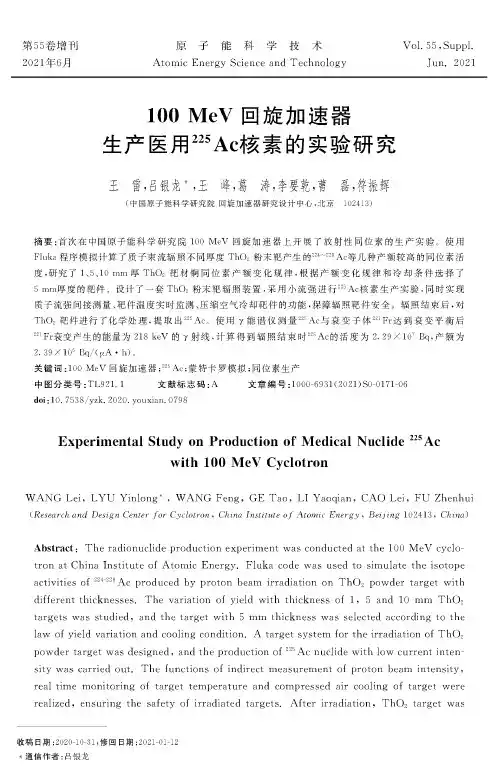
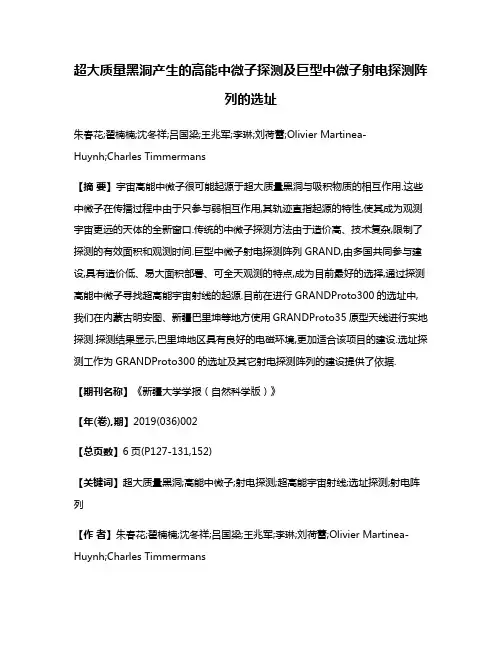
超大质量黑洞产生的高能中微子探测及巨型中微子射电探测阵列的选址朱春花;翟楠楠;沈冬祥;吕国梁;王兆军;李琳;刘荷蕾;Olivier Martinea-Huynh;Charles Timmermans【摘要】宇宙高能中微子很可能起源于超大质量黑洞与吸积物质的相互作用.这些中微子在传播过程中由于只参与弱相互作用,其轨迹直指起源的特性,使其成为观测宇宙更远的天体的全新窗口.传统的中微子探测方法由于造价高、技术复杂,限制了探测的有效面积和观测时间.巨型中微子射电探测阵列GRAND,由多国共同参与建设,具有造价低、易大面积部署、可全天观测的特点,成为目前最好的选择,通过探测高能中微子寻找超高能宇宙射线的起源.目前在进行GRANDProto300的选址中,我们在内蒙古明安图、新疆巴里坤等地方使用GRANDProto35原型天线进行实地探测.探测结果显示,巴里坤地区具有良好的电磁环境,更加适合该项目的建设.选址探测工作为GRANDProto300的选址及其它射电探测阵列的建设提供了依据.【期刊名称】《新疆大学学报(自然科学版)》【年(卷),期】2019(036)002【总页数】6页(P127-131,152)【关键词】超大质量黑洞;高能中微子;射电探测;超高能宇宙射线;选址探测;射电阵列【作者】朱春花;翟楠楠;沈冬祥;吕国梁;王兆军;李琳;刘荷蕾;Olivier Martinea-Huynh;Charles Timmermans【作者单位】新疆大学物理科学与技术学院,新疆乌鲁木齐830046;新疆大学物理科学与技术学院,新疆乌鲁木齐830046;新疆大学物理科学与技术学院,新疆乌鲁木齐830046;新疆大学物理科学与技术学院,新疆乌鲁木齐830046;新疆大学物理科学与技术学院,新疆乌鲁木齐830046;新疆大学物理科学与技术学院,新疆乌鲁木齐830046;新疆大学物理科学与技术学院,新疆乌鲁木齐830046;索邦大学、巴黎狄德罗大学、巴黎索邦西岱大学,法国;中国科学院国家天文台,北京100012;奈梅亨大学数学、天体物理与粒子物理研究所,荷兰;荷兰国家核物理与高能物理研究所,荷兰【正文语种】中文【中图分类】P161中微子具有不参与电磁相互作用、强相互作用的特性,在传播过程中几乎不改变传播方向,轨迹直指起源地[1].2013年,南极Icecube中微子实验在《Science》发表,声称已经观测到地外高能中微子,这一发现预示着中微子天文学时代的到来[2].去年,Icecube又发现高能中微子就可能起源于正在吸积物质的超大质量黑洞[3].特别是最近,视界望远镜给出了一座质量高达65亿倍太阳质量的超大质量黑洞照片[4].对高能中微子的探测是解决超高能宇宙射线起源问题的重要手段.由于其特性,天文学家可以通过对它的观测了解宇宙中更远的天体.这种特性也导致人们对它的探测十分困难,为得到统计上可观的宇宙中微子事件需要巨大的探测器.目前对中微子的探测主要分为三种方法[5,6]:(1)使用表面粒子探测器.由于高能中微子在传播过程中与周围的分子或原子之间弱的相互作用,引发粒子级联效应,粒子数量增多,可以通过探测大气中粒子的分布来确定初期粒子的到达方向,例如TA(The Telescopes Array)、HAWC(The High-Altiude Water Cherenkov)等.然而,由于粒子探测器造价昂贵限制了有效探测面积;(2)使用光学探测器.中微子在相对透明的介质中相互作用时会产生Cherenkov光或荧光效应,可以通过在介质(例如水,冰等)中部署相关的探测器进行探测这些事件,例如POEMMA(The Probe Of Multi-Messenger Astrophysics)、AMANDA(Muon and Neutrino Detector Array)等,在大气中使用光学探测器,会受天气和光照的严重影响,因此运行时间受限,而建立在冰层、水中的探测器阵列,加大了大面积部署的难度;(3)使用射电阵列.当粒子速度超过介质中光的相速时,会产生不对称的带电粒子分布,进而产生相干的射电辐射,即Cherenkov 辐射,而且宇宙次级带电粒子在地磁场中产生同步辐射,这种辐射波段在射电波段[7],可以使用射电技术探测.与传统的探测手段比较,具有价格便宜、易于大面积部署、易维护、接近100%的观测时间的优势,例如在南极冰层中部署的IceCube探测器、以及正在建设中的巨型中微子探测射电阵列GRAND(The Giant Radio Array for Neutrino Detection). GRAND旨在通过探测高能中微子寻找超高能宇宙射线的起源[8],采用模块式安装,易于维护,可大面积的部署,使用山体当做自然靶标提高探测高能中微子事件效率,其预期灵敏度将比IceCude 要高一个量级,甚至更好.GRAND 计划在10∼15年的时间在200 000 km2的面积上,部署100 000 根天线,GRAND的建成将成为世界上最大的宇宙中微子探测器.GRAND 科学目标分为三个阶段:第一阶段进行快速射电爆、巨型射电脉冲,再电离时代的研究;第二阶段进行超高能宇宙射线的研究工作;第三阶段开启EeV中微子天文学、中微子物理学、超高能伽马射线研究.加速探测高能中微子领域的快速发展[9],在国内该项目由武向平院士作为带头人,多所科研机构参与,共同推进该项目的设备部署和后续工作的开展.1 GRAND高能中微子探测原理当高能带电粒子、伽马射线或中微子到达地球时,与大气中的原子或分子相互作用产生次级粒子.次级粒子再与周边大气作用,产生更多二级的粒子,以此连续下去产生级联效应,诱发广延大气簇射[10].宇宙射线的直接探测手段,使用天线阵列直接接收粒子在进入大气后产生的射电辐射.第一种射电辐射来自于其本身带有电荷,在地磁场的影响下,运动粒子的簇射前端正负离子发生分离,诱发横向电流,伴有线偏特性的射电辐射[8].该方法不受天气和天光条件的影响,具有较长的有效观测时间.第二种伴随大气簇射发出的射电辐射机制是切伦科夫辐射的低频对应—Askaryan效应—粒子在介质中的运动速度超过光的相速度时诱发次级带电粒子,引发电荷过剩,电荷随时间的变化引发射电辐射.在大气中由于ASkaryan效应比地磁场中的辐射弱数倍,所以在此过程中地磁辐射占据主导地位.GRAND项目通过探测高能中微子在地下相互作用和在大气中相互作用产生的广延簇射事件.在地下稠密的岩石介质增加了中微子在其中发生相互作用的机会,GeV 能级以上的中微子与核子相互作用,通过深度非弹性散射[11,12].在电性流相互作用中,中微子与核子相互作用,吸收一个W 玻色子转变为对应的带电轻子,而末态的轻子类型与相互作用前一致,W 玻色子迅速衰变,即:其中N可以是质子或原子,X代表末态的强子.在中性流相互作用中,中子与核子相互作用,吸收一个Z玻色子转变为相应的中微子,而末态的中微子与相互作用前一致,因此无法区分,即:由于中微子ve 发生电流性相互作用,能量损失通过辐射的方式释放,在岩石介质中的相互作用辐射截面积小,大多数在内部被吸收.因此探测到的概率较低,所以忽略对ve 探测的可能性;中微子vµ 发生电流性相互作用,从岩石表面出射后有较长的轨迹,在天线阵列上端发生簇射的概率低,所以其被探测到的可能性忽略不计;中微子vτ 质量比vµ 和ve 的质量大,发生电流性相互作用辐射能量衰减被进一步抵制,当vτ 穿过岩石介质之后由相互作用产生τ子,τ子会在天线阵列上方发生衰变诱发广延大气簇射,并产生在射电频段内的信号.因此在GRAND的部署和选址工作中,主要目标位置集中在有山脉的无人地区,山体不仅可以增加高能中微子的探测事件概率,还可以屏蔽和吸收由人为造成电磁噪声.图1 不同味中微子的传播示意图Fig 1 Schematic diagram of the propagation of different neutrinos2 选址探测在选址探测过程中使用GRANDProto35天线,其前期已在乌拉斯台试运行,验证了该方案的可行性,并取得较好的探测数据.选址探测设备主要包含三对相互垂直的蝶形天线,可以对三个极化方向进行全方位采样;DAQ(数据采集),采集板初始信号段接有30∼100MHZ的无源模拟滤波器,滤波后的信号通过阈值比较,若满足触发条件则将信号包络通过12 位ADC(模数转换器)以每秒5 000 万次采样数字化,每隔3×3.6 µs 将GPS、时间信息一同打包发送到中央DAQ.此次选址探测是为了推行GRAND阶段中GRANDProto300的实施,该阶段计划在100∼300km2的面积上部署300根天线,目的是对水平簇射的射电探测实验进行验证.为解决由射电信号通过与地面反射波的相互作用强烈衰减带来的水平方向簇射的检测问题,以及到达方向分辨率随着靠近地平线而降低,导致信号难以重建的问题,选择将部分或全部部署在5∼10o的山坡上.选址探测步骤:(1)对周围环境进行视觉检测,查看周围是否有大量人类活动、高压输电线以及山体,评估访问和部署的便利性;(2)将天线X轴对向北方架设天线,测量30∼80MHz频段的瞬态噪声;(3)数据处理画出瞬态噪声图、Fourier变换后的频谱图.以下为在内蒙古、巴里坤地区的探测情况,以及在1KHz、10KHz 基线时,将乌拉斯台数据当作理想数据进行对比,同时通过设置触发阈值可以较好的消除一部分人为噪声.2.1 明安图太阳观测基地在内蒙古明安图太阳观测基地附近,海拔1 300∼1 400m.有较为平缓的山坡,人为活动较少,短距离内有基础的设施.在该地使用两副天线进行瞬态噪声探测,处理数据结果如表1,相比较理想数据而言相差较大.在后面的探测过程中,推测是由于两副天线距离较近产生的射频干涉引起,具体数据见表1.表1 明安图太阳观测基地Tab 1 Mingantu observing station探测编号测量值/理想值测量值/理想值(1kHz)(10kHz)1006.66.2 10210.09.9 10310.514.3 10514.312.8 10617.620.1表2 巴里坤山谷内Tab 2 Within the vally of Balikun探测编号测量值/理想值测量值/理想值(1kHz)(10kHz)B103A7.57.8 B31337.46.8 B31303.03.1B31324.54.6 B31316.26.12.2 巴里坤地区在巴里坤地区的探测,主要可以分为在山谷内、天籁基地附近、戈壁滩周边三部分.巴里坤山谷被大山环绕,地形宽阔平坦,15km左右有个村庄,易于访问和部署.但山谷规模有限,缺乏可用的基础设施.探测结果如表2,从山谷入口的小路旁开始探测,入口处B103A、B3133有较高的噪声,在山谷内部噪声较低,当到达山谷末端时,海拔升高,B3131的噪声也有所提高,具体数据见表2.天籁观测基地处于一个小的山谷中,有较为便利的基础设施和方便的部署和访问条件,但是其面积太小,使用相同的方式,从山谷入口处开始探测直到山谷末端停止探测.其中B3125、B3141几乎在同一地点不同时间进行探测的结果,其他测量结果,比山谷区域的结果稍好,噪声较低.具体数据见表3.在位置靠近大山的路边上,其周围有大面积的开阔区域,人为活动较少,易于访问和部署.对比在路边的两次探测结果,在戈壁路边的结果非常好,噪声较低,具体数据见表4,其中B101、3134巴里坤山谷附近;B3111、103B、3110在巴里坤县附近;B3143天籁基地附近;B3144、3146戈壁路旁.因此与大山相连接的戈壁也是值得GRAND项目考虑的部署区域.3 探测分析对两个探测点B3122、B3111的原始数据进行处理分析(图2、图3).图2 运行编号B3122测试结果Fig 2 The result of run number B3122图中为三个极化方向各自的经过傅里叶变换后频谱图和噪声频谱图.其中,右侧坐标单位 1 ADC=0.0125mV,左侧图垂直轴单位为mV,图上127 特指数据采集板的编号,三个探极化方向的数据分别对应于C1、C2、C3.图中所示从上往下分别为x轴,y轴,z轴三个极化方向的测量结果,左侧为Fourier变换后频谱图,右侧为对应的瞬态噪声.由于主要考虑到从水平方向来的噪声问题,因此偏重于x轴和y 轴的结果.对于B3122处的a、c、e 图均在30MHz附近出现峰值,其中a、c 两图在其他频率上有一些较小的起伏,而B3111处的探测数据在30∼80MHz频段内存在强烈的干扰信号,尤其是在60MHz、70MHz处存在两个尖锐的峰.b、d、f 图中分别为对应噪声,B3122处探测结果显示,趋势线集中在300ADC 范围内,而B3111处,趋势线变化不均匀,且一直延伸至最大值.在选址中观测两图,频谱图越平缓、噪声图趋势线越窄则证明探测点处没有嘈杂的电磁噪声,可以在较低的触发阈值情况下进行有效的探测,获得更多有用的信息.图3 运行编号B3111测试结果Fig 3 The result of run number B3111表3 天籁观测基地附近Tab 3 Near the Tianlai observing station探测编号测量值/理想值测量值/理想值(1kHz)(10kHz)B312517.610.0 B31414.04.7B31274.75.0 B31222.42.6 B31422.73.2 B31246.23.7 B31284.24.6表4 路边探测Tab 4 Roadside detection探测编号测量值/理想值测量值/理想值(1kHz)(10kHz)B10113.013.1 B31344.65.0 B311114.211.3B103B8.97.4 B31103.53.7 B31434.34.7 B31444.95.7 B31463.33.74 总结探测结果表明在内蒙古探测过程中,两根天线间距较近会严重影响探测结果.在新疆巴里坤地区探测结果显示,在四周环山的区域电磁噪声相对较小其大部分结果都符合选址要求.新疆地区具有优越的地理位置,为GRAND的选址提供了优质的选项.为GRAND 原型阵列的建造,进一步对相关技术进行验证,选址探测为GRANDProto300以及将来建造的射电探测阵列提供了依据.GRAND 的建成将提供大的机遇,开启高能中微子天文学潜力巨大的观测窗口,使我国能在该领域快速发展,使该地区成为国际高能中微子研究的探测中心、学术中心.致谢感谢中国科学院院士武向平老师给予的帮助,使得我能够有这样一个机会接触到该项目,了解目前中微子探测的进展,参与到选址探测的工作中来.感谢国家自然科学基金11763007,11473024,11463005,11863005,11803026 和11503008的支持,也感谢新疆天山雪松基金2017Q014的支持.参考文献:【相关文献】[1]Anchordoqui L A,Barger V,Cholis I.Cosmic neutrino pevatrons:A brand new pathway to astronomy,astrophysics,and particle physics[J].J HEAP,2014,1:1-30.[2]Aartsen M G,Abbasi R,Abdou Y.Evidence for high-energy extraterrestrial neutrinos atthe IceCubedetector[J].Science,2013,342:1242856.[3]Aartsen M G,Abbasi R,Abdou Y.et al.,Multimessenger observations of a flaring blazar coincident with high-energy neutrino IceCube-170922A[J].Science,2018,361:6398.[4]Akiyama K,Alberdi A,Alef W,et al.First M87 Event Horizon Telescope Results.I.The Shadow of the Supermassive Black Hole[J].Ap J,875,1.[5]Cao Z,Xiao G.The status of Ultra high energy neutrino experiments[J].ModPhys,2007,19:18-24.[6]翁路华,施浒立,高超,等.高能宇宙射线射电探测系统接收天线设计[J].电气与仪表技术,2009,4:93-96.[7]张建立,张毅.天山射电实验探测极高能中微子和宇宙射线[J].中国科学,2015,45(11):119511-1-7.[8]Giant Radio Array for Neutrino Detection:Science and Design.arXiv:1810.09994v1.[9]Waxman E,Bahcall J N.High energy neutrinos from astrophysical sources:An upper bound[J].Phys Rev D,1999,59:023002.[10]O C 阿尔科费尔.宇宙线入门[M].徐春娴,朱清棋,译.北京:科学出版社,1987:3-7.[11]Raj Gandhi,Chris Quigg,Mary Hall Reno,et al.Ultra high-energy neutrino interactions[J].Astroparticle Physics,1996,5:81.[12]Raj Gandhi,Chris Quigg,Mary Hall Reno,et al.Neutrino Interactions at Ultrahigh Energies[J].Physical Review D,1998,58:093009.。
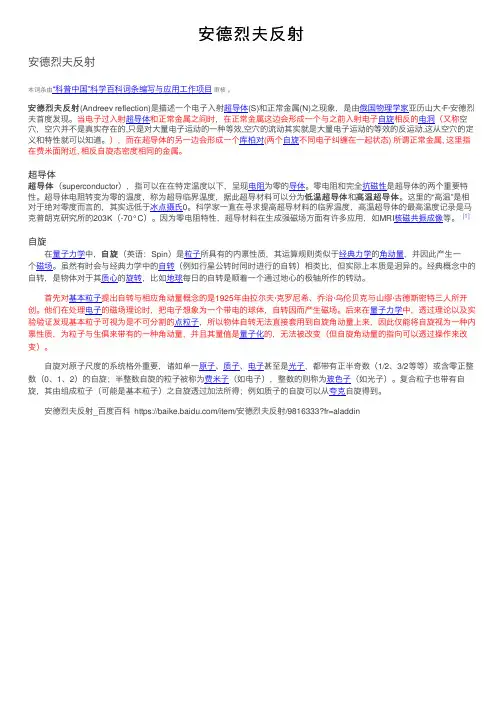
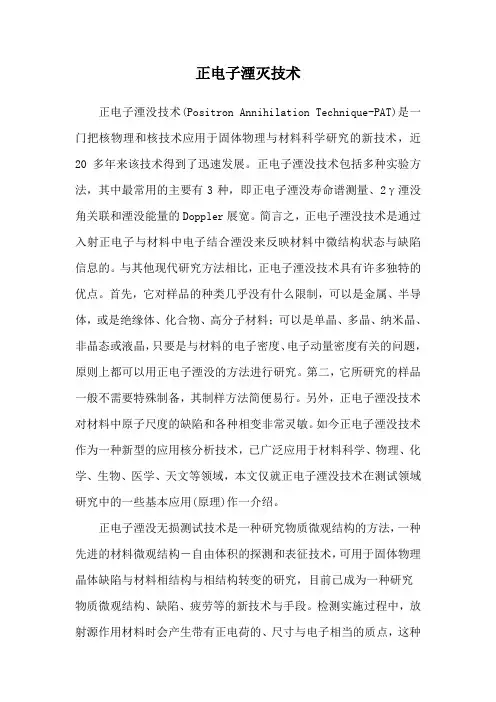
正电子湮灭技术正电子湮没技术(Positron Annihilation Technique-PAT)是一门把核物理和核技术应用于固体物理与材料科学研究的新技术,近20多年来该技术得到了迅速发展。
正电子湮没技术包括多种实验方法,其中最常用的主要有3种,即正电子湮没寿命谱测量、2γ湮没角关联和湮没能量的Doppler展宽。
简言之,正电子湮没技术是通过入射正电子与材料中电子结合湮没来反映材料中微结构状态与缺陷信息的。
与其他现代研究方法相比,正电子湮没技术具有许多独特的优点。
首先,它对样品的种类几乎没有什么限制,可以是金属、半导体,或是绝缘体、化合物、高分子材料;可以是单晶、多晶、纳米晶、非晶态或液晶,只要是与材料的电子密度、电子动量密度有关的问题,原则上都可以用正电子湮没的方法进行研究。
第二,它所研究的样品一般不需要特殊制备,其制样方法简便易行。
另外,正电子湮没技术对材料中原子尺度的缺陷和各种相变非常灵敏。
如今正电子湮没技术作为一种新型的应用核分析技术,已广泛应用于材料科学、物理、化学、生物、医学、天文等领域,本文仅就正电子湮没技术在测试领域研究中的一些基本应用(原理)作一介绍。
正电子湮没无损测试技术是一种研究物质微观结构的方法,一种先进的材料微观结构-自由体积的探测和表征技术,可用于固体物理晶体缺陷与材料相结构与相结构转变的研究,目前已成为一种研究物质微观结构、缺陷、疲劳等的新技术与手段。
检测实施过程中,放射源作用材料时会产生带有正电荷的、尺寸与电子相当的质点,这种正电子可以被纳米大小的缺陷吸引而与电子相撞击。
在正负电子撞击过程中,两种质点湮没,从而放出一种伽玛射线。
伽玛射线能谱显示出一种清晰可辨的有关材料中的缺陷大小、数量以及型别的特征。
显然,这些特征可以标识最早阶段的损伤,即裂纹尚未出现的损伤;同时可以在不分解产品的情况下定量地评估其剩余寿命,笔者对该技术的原理及其应用进行了介绍。
正电子湮没无损测试所采用的正电子源最初来自于放射源的β+源,通过放射源的作用在材料中产生正电子。
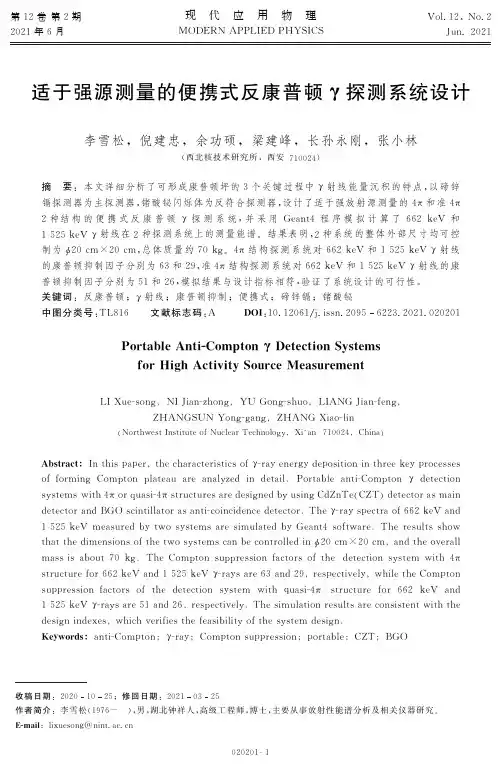
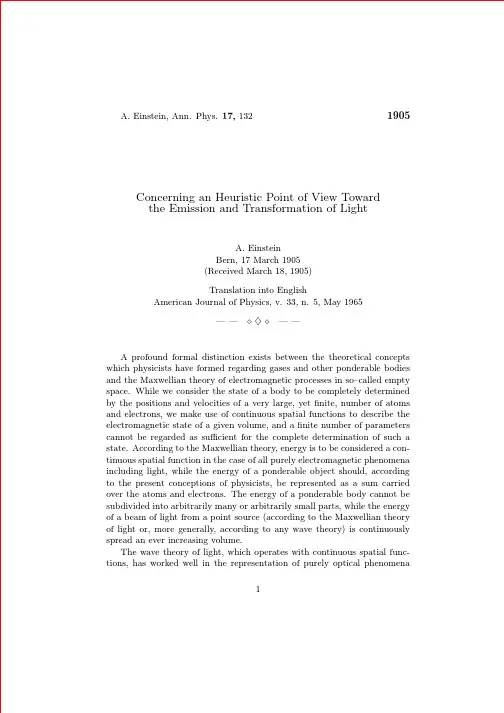
arXiv:hep-ph/9811511v2 2 Dec 1998ULTRARELATIVISTICPOSITRONIUMPRODUCTIONINCOLLISIONSOFHIGHENERGYELECTRONSANDLASERPHOTONS
MartynenkoA.P.SamaraStateUniversity,Samara,Russia
SaleevV.A.SamaraStateUniversityandSamaraMunicipalNayanovaUniversity,Samara,Russia
AbstractWeconsidertheproductionofultrarelativisticparapositroniumandorthopositro-niumatomsincollisionsofhighenergyelectrons(Ee>0.5TeV)andlaserphotons.OurresultsdemonstratetheopportunityofintensivepositroniumbeamformationwithLorentz–factorγ∼106usinglaserbeamconversiononhighenergyelectronsatthefuturee+e−LinearAccelerators.
IntroductionFormationofultrarelativisticpositroniumbeamsisofimmediateinterestasatestofmainprinciplesofquantumelectrodynamics(QED)[1]andtheoryofrelativisticboundstates[2].Inparticular,theformationofultrarelativisticparapositronium(1S0–state)andP-wavepositroniumbeamswithverylargeLorentz–factorsγgivesachancetomeasurewithhighaccuracytheirdecaywidths.Itisneededbecauseoftheoreticalpredictionsatpresenttimearemoreprecisethanexperimentaldata[3].AtverylargeLorentz–factorγ∼106thepositritroniumformationlengthisaboutseveralsmforgroundstates(n=1,3S1or1S0)[4]anditisrealtytocheckdirectlytheexponentiallawforthee+e−boundstateformationinvacuumandmatter.Atpresenttimeitisdiscusseddifferentapproachforobtainingrelativisticpositroniumbeams.Firstofall,thisispositroniumproductioninπ0–mesondecaysatProtonAccelera-tors,whichhavebeentestedexperimentallysomeyearsago[5].Relativisticpositroniumbeamsmaybeformedinhighenergyphoton[6]orelectron[7]interactionwithmatter.Recentlyitwaspredictedpositroniumproductionrateincollisionsofheavyions[8].Hereweconsidertheformationofultrarelativisticpositroniumbeams(γ≃106)vialaserphotonconversiononhighenergyelectrons.ThismethodmayberealizedatfutureLineare+e−AcceleratorsattheenergyrangeEe≈1TeV.Theideaofourcalculationisthesameonewhichhasbeendiscussedpreviously[9]inthecaseofrealizingofγe–andγγ–collisionsonthebasisofLineare+e−Collider.Thehighdensitylaserbeam(approximately1020photonsperimpulsewiththeenergyω=1eV)backscatteresonhighenergyelectronbeamofLinearAcceleratorandconvertsintohighenergyphotonbeamwithprobabilityequaltounity.Atthelaserpowerabout10JandfrequencyoflaserimpulsedivisibletoLinearColliderfrequency(f∼10÷100s−1)itwillbesomanylaserphotonsthatalmosthighenergyelectrontransfersenergytolaserphoton.Itisobviouslythatatconditionsdiscussedabove,theratio(1):
K=σ(γ+e→Ps+e)
√√
m3α3/8πisthenonrelativisticpositroniumgroundstatewavefunctionattheorigin,mistheelectronmass.Inthelowestorderinα=e2/4πpositroniumproductionintheprocessγ+e→Ps+eisdescribedbytheFeynmandiagramsinFig1.Thenonzerocontributioncomesfromdia-grams1-6forparapositroniumproductionandfromdiagrams1-4,7,8fororthopositroniumproduction:
M1=e3¯U(q2)γµˆPγµ(ˆq1+ˆk+m)ˆε(k)U(q1)/((q1−k)2−m2)(p/2−q2)2(4)M2=e3¯U(q2)γµˆPˆε(k)(ˆp/2−ˆk+m)γµU(q1)/((p/2−k)2−m2)(q2+p/2)2(5)M3=e3¯U(q2)ˆε(k)(ˆq2−ˆk+m)γµˆPγµU(q1)/((q2−k)2−m2)(q1−p/2)2(6)M4=e3¯U(q2)γµ(−ˆp/2+ˆk+m)ˆε(k)ˆPγµU(q1)/((p/2−k)2−m2)(q1−p/2)2(7)M5=e3¯U(q2)γµU(q1)Tr[ˆPˆε(k)(−ˆk+ˆp/2+m)γµ]/(q1−q2)2((p/2−k)2−m2)(8)M6=e3¯U(q2)γµU(q1)Tr[ˆPγµ(−ˆp/2+ˆk+m)ˆε(k)]/(q1−q2)2((p/2−k)2−m2)(9)M7=e3¯U(q2)γµ(ˆq1+ˆk+m)ˆε(k)U(q1)Tr[γµˆP]/p2((q1+k)2−m2)(10)M8=e3¯U(q2)ˆε(k)(−ˆp+ˆq1+m)U(q1)Tr[γµˆP]/p2((p−q1)2−m2)(11)
LetusdefinetheMandelstamvariablesfortheprocessγ+e→Ps+einthecaseofEe≫m≫ω∼1eV:
s=(q1+k)2≃m2+4ωEe,(12)t=(k−p)2≃4m2−2Eeω(1+cosθ),(13)u=(q1−p)2≃5m2−2EeE(1−cosθ),(14)
wherek=(ω,0,0,−ω)islaserphotonfour–momentum,q1=(Ee,0,0,Ee)istheinitialelec-tronfour–momentum,q2isthescatteredelectronfour–momentum,p=(E,0,Esinθ,Ecosθ)ispositroniumthefour–momentum,Eistheenergyofpositronium,Eeistheenergyofinitialelectron,θisscatteringangleofpositronium,
cosθ≃1−2ωEe+2m2
|M|2asfollows:dσ|M|2
s−m2
2m2+(s+m2)(s−3m2)
2s2ResultsofcalculationsFirstofall,tonotethatminimalvalueofinvariantsintheprocessγ+e→Ps+eissmin=9m2≈2.35MeV2andcorrespondingthresholdelectronenergyisequalto
Ee,min=smin−m2ω.(18)Attheenergyoflaserphotonsω=1eVweobtainfrom(18)Ee,min=522GeV.Ontheotherhand,atEe=1TeV(theenergyrangeoffutureLinearColliders)sisequalto4.2MeV2.Figure2showsthecalculatedtotalcrosssectionsfororthopositronium(curve1)andparapositronium(curve2)productionasafunctionofsatω=1eV.Theorthopositroniumcrosssectionhasamaximumats=3.2MeV2(orEe=735GeV),whereonehasσ(γ+e→3S1+e)≈237pbandσ(γ+e→1S0+e)≈325pb.
Theorthopositroniumproductioncrosssectiondecreasesatlargesoppositetopara-positroniumproductioncrosssectionwhichincreaseslogarithmically.Thisbehaviorcomesfromdiagrams4and5inFig1.AttheelectronenergyEe=1TeVandω=1eV(s≈4.2MeV2)wehavefoundthatσ(γ+e→3S1+e)≈218pbandσ(γ+e→1S0+e)≈494pb.Theabovementionedvaluesofcrosssectionscorrespondtoproductionofpositroniaingroundstateswithn=1.Thesummationovernenhancestheobtainedresultsbyafactorofζ(3)=∞n=11/n3≃1.202.Table2showsthevaluesofratioK(1)atdifferents.Insuchamanner,atEe=1TeVandatnumberofelectronsperimpulsen=2·1011(theprojectofe+e−LinearColliderVLEPP)itwillbeproduced∼1200parapositroniumand∼500orthopositroniumperimpulse.Attheacceleratorfrequencyf=100s−1itgives1.2·105and0.5·105positroniumatomspersecond.Thisresultexceedsthenumberofpositroniumatomswhichmaybeobtainedintherecombinationprocesse++e−→Ps+γate+e−StorageRings[11]atthesameparametersofaccelerators.TheroughestimationonP–wavepositroniumproductionrateintheprocessγ+e→Ps+γisapproximately10−4fromthenumberofS–wavepositroniumproductionrate,i.e.∼100atomspersecond.Itseems,thatsolargeP–wavepositroniumproductionratewillenoughforprecisetestoftheirdecaywidths.ThepositroniumspectradN/dy(y,s)normalizedtounityats=3.2MeV2areshowninFig.1.Thepositroniumatomsareproducedinthekinematicrange0.375≤y≤0.869withtheaveragevalues≈0.54forparapositroniumsand≈0.63fororthopositroniumsandtheyhaveultrarelativisticLorenz–factors0.27·106≤γ≤0.64·106.Inconclusionwenotethat,theobtainedvialaserphotonconversiononhighenergyelectrons,ultrarelativisticpositroniumbeamwillbepure,fromthepointofviewofhadronicbackground.Itfollowsfromthetrivialkinematicfactthatthresholdenergyofpairπ–mesonproductionisEmin≈2·104TeVatω≈1eV.